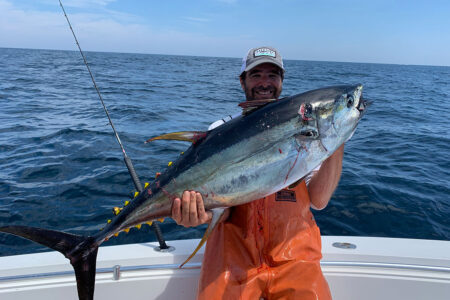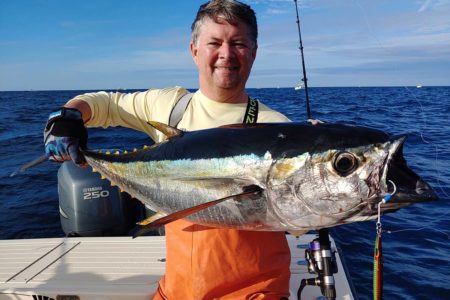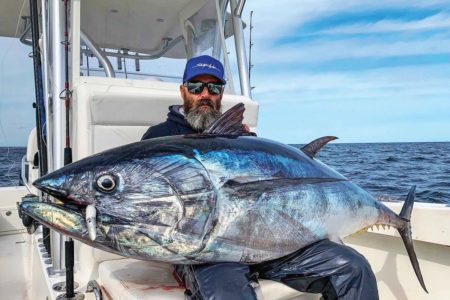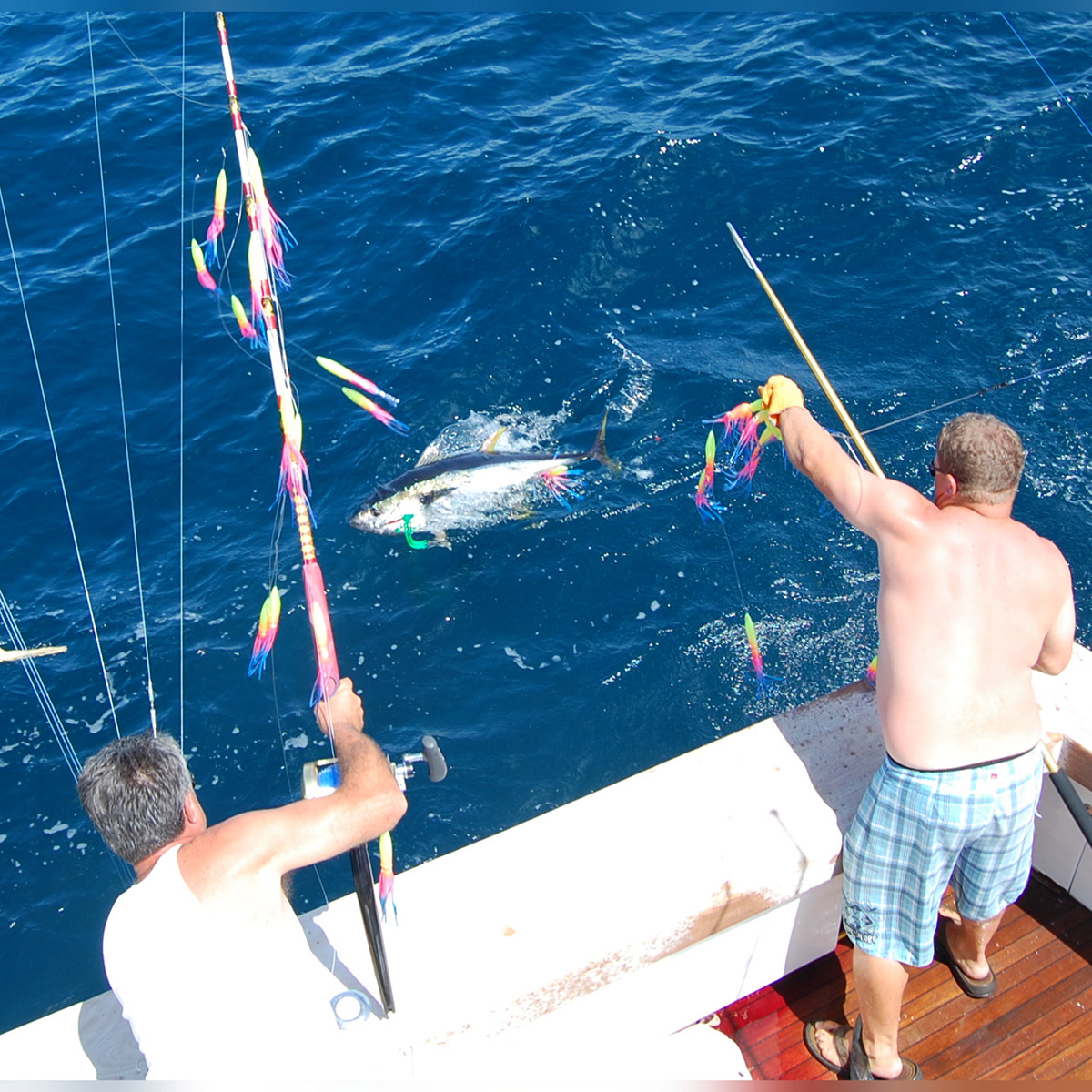
Until you know what fish find to their liking on any given day, a mixed spread is the best way find the hot color and size.
The list of items required to put an offshore trip together is extensive; fuel, bait, tackle, ice, drink, food, not to mention time that’s invested in rigging rods, lures and bait like ballyhoo, squid, and the like. And after all the effort/cost required before lines even get wet, it would be nice to think we have a good chance of finding success after running out to the edge.
That age old quote, “a bad day fishing is better than a day at work” will receive no argument from any angler. However, I think we would all agree “a day catching fish is way better than a day at work!”
Spreads can be set to entice certain species when desired. But by starting the day off dragging a mixed spread, anglers can find out what species are cooperative and the bait de jour.
First Things First
Before getting into the nuts and bolts of deploying a mixed spread, the first step all anglers must make is to decide the boat’s compass heading. Information is one of an angler’s most important tools in the box. A blind chicken may find a piece of corn, but one that sees eats all day. The night before the trip, take the time to walk the docks (if practical) and observe what actually was caught by the charter/private boat fleet – seeing is believing. This recon gives a clue as to what “might” be expected to grab a line the next day. Keep in mind this is no guarantee since conditions change from day to day, but those flags flying off outriggers give a pretty good clue to how fishing was that day.
The fish cleaning station’s carcass barrels offer information as well; but nothing is better than hearing it firsthand. Successful anglers are often willing to share information after a day offshore that puts smiles on faces. Cold celebratory libations flowing in cockpits after dock lines are secure loosen lips as well. Personally, I never minded answering a few questions while cleaning gear after a long day offshore, once the charter departed. However, don’t ask for GPS numbers; keep questions generalized. “I’m running offshore tomorrow, got any tips?” This allows me to give as much or little information as I’m comfortable providing. Base your follow-up questions on my answer.
Some captains may stare at you like you’ve spoken in an unknown language, while others will be cooperative and offer sincere advice or be politely standoffish. On rare occasions I’ve even provided location information for a newbie I felt needed and would really appreciate the help during their learning curve. Be sure to stop back by with a “thank-you for the intel” after finding success and create a two-way street of information. It could be the beginning of a good fishing relationship.
Pay particular attention to what type lures/rigs and colors are being washed off or lying around in the pits. Again, no guarantee the next day yellowfin will be partial to blue/white, but if my pit has four rods with blue/white skirts, you can be pretty darn sure that was the hot color that day. Another excellent source of information is the bait/tackle shops. The owners/clerks get to hear stories of what, where and how fish were caught by many customers. When picking up your bait/terminal tackle, pick his or her brain. They want you to be successful as it is good for business. Finally, social media can provide information as well, however it is often a couple days old and, well, let’s face it, anglers tend to exaggerate!
In the Spread
Most offshore anglers leave the slip with intentions of catching tuna or marlin. But in all honesty, screaming drags and bent rods are what anglers want after a three hour run to the deep. Even if the gaffer mahi was not the intended quarry, I’ve never seen an angler turn up his nose at fresh dorado. There is no way of knowing exactly what size/type pelagic will be lurking out on the edge. And there is certainly nothing wrong with a kill box containing mahi, wahoo or even flying flags of billfish releases at day’s end. If strictly targeting tuna or marlin, the spread can be tailored to those species. But for now, let’s try to attract something into the spread, get rods bending and your crew shouting for joy.

A mixed spread is just that, different size, color and type of bait/lures to attract various species and sizes of pelagics. A spread can be any amount of rods – boat size, ability and weather dictates how many rods can be trolled without tangling. Spreads are tailored to time of season and what pelagic species are available. For example, when wahoo are abundant in late season, anglers may want to insert three offerings of black/purple, black/blue or black/red in the spread, by far the favorite colors to get their attention. Yellowfin find these colors to their liking as well, but when yellowfin are observed plentiful on the cleaning tables the day before, at least two spreader bars should be pulled.
If trolling inside on the 20 fathom line, king mackerel and big bluefish may be in the mix as well, and a 5-1/2 drone spoon using #1 or #2 size planer should replace one flat line bait. Bait offerings should also be downsized when in on the 20 line as blue marlin are practically non-existent inshore. Again, walking the dock before your trip can help significantly when it comes to fine tuning your spread.
A Basic Eight
Your basic eight line spread assumes you are equipped with outriggers, either rigged with double lanyards or single lanyard with two release clips. Starting with the flat lines, one has a small naked rigged ballyhoo or short skirted ballyhoo (trim skirt to 3 inches) set approximately 17 to 20 feet behind the transom. Depending on boat speed/current, the chin weight will be 1/4 to 1/2 ounce. This is the closest line to the boat and the rigged ballyhoo must look natural, swimming just under the surface. I can’t emphasize this point enough; the bally should not be turning on its side or spinning in circles, but must look like it is swimming in the water. Rigged properly with the scales “popped” along the top of the backbone, it should appear lifelike. For detailed information on preparing ballyhoo, go to YouTube and search for my video, Earth Sports: How to Rig Ballyhoo for Billfish with Circle Hooks, which shows how I rig ballyhoo for circle hooks. The preparation of the ballyhoo is the same for circle hooks or j-hooks.
On the other corner of the transom, in lieu of a second flat line, use a planer to get bait deep. Attach a Z-wing or other type planer to 50 feet of tow line and pull from transom cleat. Use extreme caution when setting Z-wing/planer as to not get fingers wrapped in the tow line. Pulling the boat out of gear when setting the planer is a great idea. With planer set, resume speed and position with the bait 100 feet behind boat. Wrap a rubber band around the fishing line, and attach to one side of a double end snap swivel, and clip the other side of the snap to the planer tow line.

Slowly spool line off the reel and the clip will slide down the tow line. Once at its desired depth, set the drag. The rubber band will break on the bite. Rig this rod with a 5-1/2 Drone spoon (white or silver) or a black/purple Jr Ilander skirted over a medium ballyhoo. This bait should be set at a depth of 20 to 30 feet (Watch sonar to see depth where fish/bait are holding.). If your pit is large enough, two rods can be pulled off one planer. If not using a planer, set a second flat line with a 6-inch single cedar plug (natural color or blue/white) or cedar plug daisy chain off the second flat line, set back 25 feet. However, deep bait is the preferred choice for this rod position, especially when wahoo are in the vicinity. The deep line is also the ticket once the sun is high or on days when fish are marked on sonar but refuse to rise and feed.
One short rigger will be a multi-colored spreader bar rigged with a green machine replacing the last squid. This will be positioned around 50 feet back or what many anglers refer to as the third to fourth wave. The other short rigger will be a blue/white Ilander skirted over a medium ballyhoo (or large/horse ballyhoo “if” blue marlin are in area) and set at 60 feet, the fourth to fifth wave. A sweet spot rod is set in the center of the spread, in-between the short and long rigger lines. Drag a black/purple Ilander skirted over a medium ballyhoo or use a small bird with daisy chain consisting of 4- or 5-inch pink chuggers to churn water in the middle of the spread.
The long riggers consist of two skirted ballyhoo. In early morning or low light conditions (cloudy) skirt one medium ballyhoo in dark colors and set it at 90 feet. As the sun rises change this skirt to brighter colors (Pink is a good choice.). For the other long rigger skirt, set a small ballyhoo in green/yellow at 125 feet. This is a good color for mahi when trolling by flotsam or weedlines. Finally a shotgun rod drags a green bird with triple green machines about 50 feet behind the far long rigger lines. If bluefin are in area set this back at least 100 feet behind the longest rigger line.
Of course the spread can be modified by increasing or decreasing the number of rods. Adjust lines so bait/lure runs on the front surface of boat waves. Don’t be afraid to change up and try different lures or bait, such as rigged squid. Just keep in mind, until you know what fish find to their liking on any given day, use a mixed spread to find the color and size of bait preference. Once this is determined, change up the spread and present more of these offerings. For example, if a spreader bar rigged with green machine catches a yellowfin; at the very least, insert another green machine into the spread or another spreader bar rigged with a green machine.
For information on how to rig planers and or other techniques mentioned in article, check out John Unkart’s books Offshore Pursuit or Saltwater Tales.
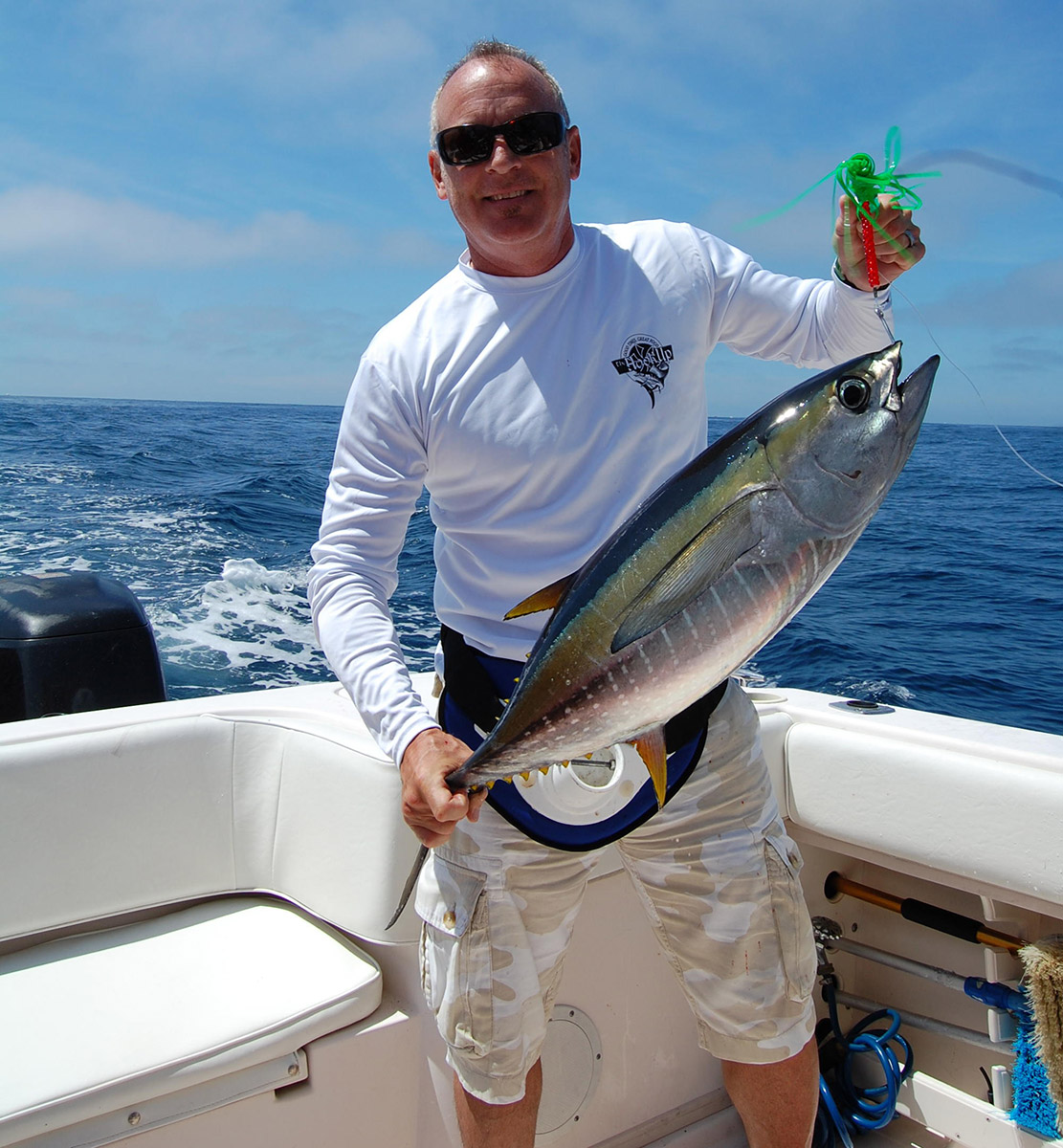
| THE DREDGE |
|---|
| Many anglers have the notion that teasers and dredges are only for billfishing; this is a misnomer. They are important weapons in the offshore arsenals and attract all types of pelagics and should be utilized in all spreads when possible. Dredges ideally should be pulled off riggers in clean water, assuming your riggers can handle the weight. Otherwise they may be pulled from the corner of the transom. If utilizing a planer, no dredge is pulled on that side. Teasers are pulled from outriggers and positioned between the flat lines and short rigger bait. It is also advisable to rig and have a pitch rod ready to go in the pit for the bait and switch, just in case a billfish pops up on a teaser! |
